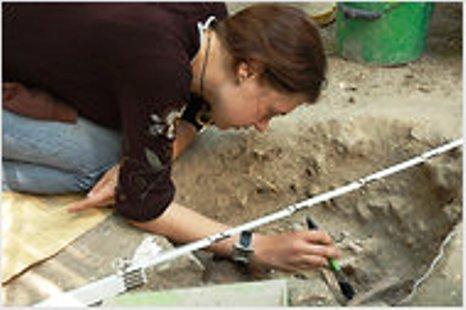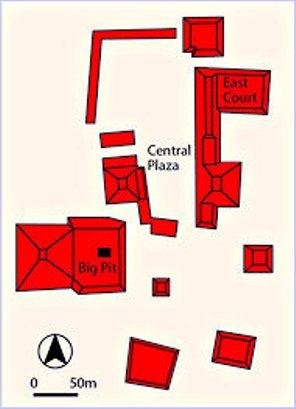In Maya Burials, Unsettling Clues
Daniela Triadan
Source - http://scientistatwork.blogs.nytimes.com/2011/02/28/in-maya-burials-unsettling-clues/?partner=rss&emc=rss
Excavations
Part 1 , Part 2
Two weeks ago we found our first burial. Anastasiya Kravtsova, the Russian student from Siberia who joined us for this field season and is working with me in the East Court, was understandably excited. Finally, we had something other than rocks. I said, “Be careful what you wish for.”

Takeshi Inomata - Anastasiya Kravtsova and her crew.
As exciting as this find may be, it also slows down the excavations significantly, because we painstakingly have to clean the bones, take photographs and draw the burial. And our goal for this season is to reach bedrock in this area.

Takeshi Inomata - Anastasiya cleaning one of the burials.
True to my prediction, we found a second burial five days later and have just removed the last bones. We carefully cataloged all the bones before we finally took them to our field lab, where Anastasiya continued the work at night because the skulls had to be cleaned before the soil hardened too much.
We were often closely observed by a curious family of howler monkeys that hovered right over our excavation. When the howlers lurk, you’d better wear a hat, because your excavation may easily turn into their bathroom. This will also mess up your soil phosphate data. Instead of a signature for ancient Maya trash, you may have measured recent monkey dung.
We found the burials in front of a structure dating to the middle part of the Preclassic (600 to 300 B.C.) in a 4-by-5-meter excavation area that extends the original 2-by-2-meter Harvard project test pit dug in the 1960s. The burials consisted of two relatively small but deep pits that had been cut through six floors.

Takeshi Inomata - The two burials in front of a Preclassic structure.

It turned out that the buried individuals had not been treated very well. The person in the first burial was a teenager, less than 17 years old, who appears to have been dismembered and then put into the pit. The lower jaw was missing. In the second burial we found a baby and maybe another person’s head, so again we may have some evidence for some ritual treatment of one of the bodies. We still need to find out when exactly those people were buried. They may date to the later occupation of the court and were probably put there as offerings during the construction of a building that dates to the Late Classic (A.D. 600 to 850).
The next steps in analyzing the remains will be the closer examination of the bones by our physical anthropology colleagues. Juan Manuel Palomo, one of our graduate students in the Ph.D. program at the University of Arizona, will look at the bones to see if he can find actual cut marks and to assess how healthy the individuals were. (Judging from the teeth that we did find, the teenager looks pretty healthy). He will also reconstruct their original height and get a better approximation of their age. Dr. Lori Wright at Texas A&M University, who supervises Juan Manuel’s work and is our physical anthropologist on the project, will conduct isotope analysis to find out what and how well they ate and whether they were born and raised at Ceibal. We may also date the bones themselves by radiocarbon to find out when they were buried. These data will continue to contribute to our knowledge about population movements and changing ritual practices through the 2,000 years of occupation at Ceibal.